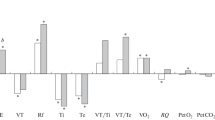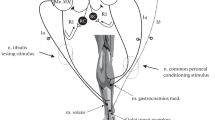Summary
Observations were made on 8 adult dogs in which the spinal cord was divided between the VI and VII thoracic vertebrae. Massage, scratching, and electrical stimulation were used to prevent dystrophy in the caudal portion of the cord. Two dogs were not stimulated, in two treatment was started after 2 months, while in the remainder the special stimulation treatment was started 2 weeks after the operation.
The activity and stability of various spinal cord reflexes and the ability to form atypical reactions served as the indices of the functional condition of the distal portion. The results of the experiments showed that the stimulation, especially when begun soon after the operation, was effective in arousing various spinal cord reflexes, even to the extent of elaborating new ones.
When no special stimulation was given, after only a few months, there was an almost complete loss of reflexes with inevitable deterioration of the condition of the muscles and joints and of locomotion.
Similar content being viewed by others
Literature Cited
M. M. Krugly, in book: Problems of the Experiment and Clinical Study of the After-Effects of Damage to the Spinal Cord, In Russian. (1956) p. 193.
V. N. Moshkov, Remedial Physical Culture and Methods of Restorative Therapy in Damage to the Spinal Cord. In Russian. Dissertation. Author's abstract. 1944.
V. N. Moshkov, Kh. M. Freidlin, M. Ya. Rotova, Gospital'noe delo, No. 12, p. 21 (1944).
T. N. Nesmeyanova and N. M. Shamarina, Doklady Akad. Nauk SSSR, volume 96, No. 3 p. 673 (1954).
A. N. Trankvilitati, Problem of the Early Application of Therapeutic Exercise and Massage in Patients with Open and Closed Vertebral Fracture and Damage to the Spinal Cord. In Russian. Collected Reports of the Siberian Hospital Clearing Stations. In Russian. V. O. (1944).
V. M. Ugryumov, in book: Problems of the Experimental and Clinical Study of the After-Effects of Trauma of the Spinal Cord, In Russian. (1956) p. 21.
S. I. Uarova-Yakobson, Transactions of the GIS (State Institute of Literary Readings), 6, p. 103 (1940).
V. K. Khoroshko, Physiotherapy and Traumatology, 10, 30 (1941).
H. Dinken, Med. Clin. North Amer. 27, 1077 (1943).
L. Guttmann, Med, history of the second world war, Surgery. (London, 1953) p. 422.
T. A. Joster, Physical Therapy, 1941, No. 3, p. 1.
C. Long, and E. Lawton, Arch. Phys. Med. and Rehabilit, 36, 4 (1955).
Author information
Authors and Affiliations
Rights and permissions
About this article
Cite this article
Nesmeyanova, T.N. Cutaneous stimuli and their relation to spinal reflexes in the dog. Bull Exp Biol Med 48, 1200–1204 (1959). https://doi.org/10.1007/BF00785170
Received:
Issue Date:
DOI: https://doi.org/10.1007/BF00785170




